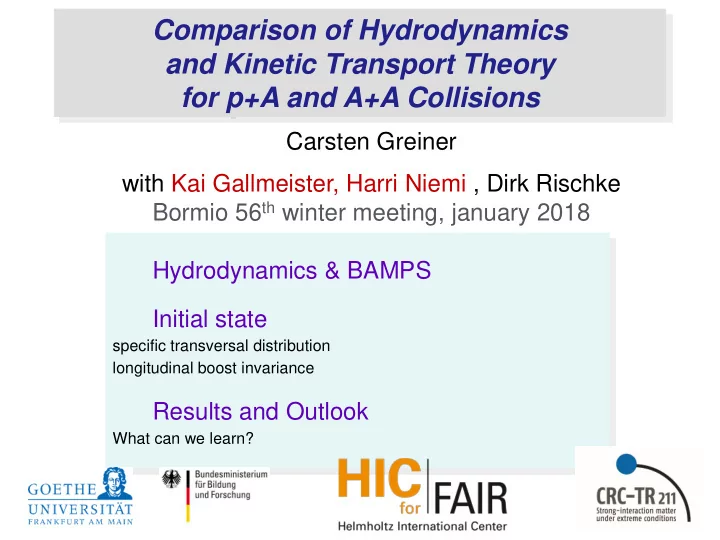

Comparison of Hydrodynamics and Kinetic Transport Theory for p+A and A+A Collisions Carsten Greiner with Kai Gallmeister, Harri Niemi , Dirk Rischke Bormio 56 th winter meeting, january 2018 Hydrodynamics & BAMPS Initial state specific transversal distribution longitudinal boost invariance Results and Outlook What can we learn?
BAMPS B oltzmann A pproach to M ulti- P arton S cattering (3+1)D Boltzmann equation Z.Xu, C.Greiner, PRC 71 (2005) 064901 Z.Xu, C.Greiner, PRC 76 (2007) 024911 Massless particles: partons / quarks & gluons Discretized space and time Testparticle ansatz:
Nuclear modification factor R AA Phys. Rev. Lett. 114 (2015) 112301 • Hadronization of high 𝒒 𝒖 partons with AKK fragmentation functions • LPM parameter fixed by comparison to RHIC data • Realistic suppression both for RHIC and LHC 3
Elliptic flow v 2 Phys. Rev. Lett. 114 (2015) 112301 • Same pQCD interactions lead to a sizeable elliptic flow for bulk medium No hadronization for bulk medium → no hadronic after-burner • 4
Hydro vs BAMPS in 1D A. El, Z. Xu, C. Greiner, PRC 81 (2010) 041901 A. Jaiswal, Phys.Rev.C87:051901,2013 x=0: Israel-Stewart > Resummation works at strong dissipation x=3: third-order rel. diss. hydro (large Knudsen number!). x=5/3: approximative ‘all - orders’
Relativistic Fluid Dynamics Conservation laws & tensor decompositions
Relativistic Fluid Dynamics Transient / second order fluid dynamics (e.g. Israel & Stewart) ( and independent variables) Second order coefficients from G.S.Denicol, H.Niemi, E.Molnar, D.H.Rischke, PRD 85, 114047 (2012) Expansion in Knudsen and (inverse) Reynolds number Hydrodynamical limit: and
Comparison Hydro / BAMPS in 3D Collectivity in Heavy Ion Collision? Fast Thermalization? Flow? How small can system be, how large can gradients be, until disrepancies occur? A+A p+A, p+p Longitudinal: Boost invariant Transversal: Radial symmetric, large/small system Glauber; overlapping Woods-Saxon
Comparison 1: Radial symmetric Longitudinal: boost invariant A+A p+A, p+p Transversal: Rotational symmetric Gaussian density profile, or Temperature Fugacity start in full equilibrium only gluons Cross section: Elastic Isotropic Constant
Comparison 2: Glauber Longitudinal: boost invariant A+A Transversal: Overlapping Woods-Saxon = (“nBC“) Impact parameter dependence selected value: 7.5 fm Temperature Fugacity start in full equilibrium only gluons Cross section: Elastic Isotropic Constant
Available eta/s
Comparison: Glauber A+A Knudsen number Hydrodynamical limit:
Comparison: Glauber A+A Glauber, 5mb: energy density & velocity 5mb: still very nice agreement
Comparison: Glauber A+A Pressure ratio: P L /P T (in the LRF) 5 mb 100 mb 5mb: still very nice agreement
Comparison: Glauber A+A Glauber, 5mb: shear stress tensor 5mb: still very nice agreement
Comparison: Glauber A+A Asymmetry: 5 mb 100 mb
Comparison: Radial symmetric (small) Knudsen number Hydrodynamical limit:
Comparison: Radial symmetric (small, 5mb)
Comparison: Radial symmetric (small, 1mb)
Comparison: Radial symmetric (large) Pressure ratio: P L /P T (in the LRF) 1 mb 20 mb
Comparison: Radial symmetric (small) Pressure ratio: P L /P T (in the LRF) 1 mb 20 mb
Comparison 2: Glauber A+A Spectra:
Comparison 2: Glauber A+A Flow: Large uncertainty due to viscous correction terms Strong dependence on freeze out conditions
Comparison 2: Glauber Flow:
Comparison 2: Glauber Flow:
Comparison 2: Glauber, escaping probability 6 % 15 % 25 % 50 %
Conclusions Comparison of 3D Bjorken Scenario Radial symmetric configuration Nice agreement (~10%) for densities, temperatures, velocities Systematic deviation of fugacities Deviations in components of shear-stress tensor No difference between large and small system Asymmetric configuration Same agreement as in radial symmetric case e P and flow v 2 : nice agreement, dependence on freeze-out Work in progress: quantify deviation as function of Knudsen number ToDo: hot spots, anisotropic hydro , … Work in progress: Greif, Schenke, …; IP -Glasma for p+A
Heavy-ion collisions are complex ! Dynamical bulk description Gluon saturation Glauber Early thermalisation jet quenching and recovery Energy loss QGP No model can describe all aspects of the QGP evolution
Heavy flavor and charged hadron R AA at LHC LHC 30
Transport coefficients shear viscosity ongoing projects: we have studied: → baryon diffusion coefficient → shear viscosity → charm diffusion coefficient → heat conductivity → study effective couplings → electric conductivity → momentum broadening: 𝒓 31
time evolution of viscous shocks t=0.5 fm/c t=1.5 fm/c η/s = 1/(4 π) t=5 fm/c t=3 fm/c Tleft = 400 MeV Tright = 320 MeV
Recommend
More recommend